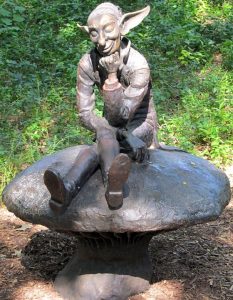We’ve all heard of fairy tales, which are not always about fairies, but instead of reading about these adventures, how about telling fairy stories? This activity can be done inside, or outside, like we did on a forest and garden tour. Once upon a fairy…
Did you know that making up stories with your child is a super learning activity as well as lots of fun? Once upon a time there was a fairy who lived in a house in the forest…
As adults, we take the basic structure of a story for granted but children are only beginning to understand that stories have a beginning, middle and end sequence. Some of them have dialogue. Stories are usually built around one event or idea. When you tell your child a story you will use this same structure even if you are not aware of doing so. As with so many things, kids need to experience this same pattern over and over before it gets recorded into their thinking strategies.
Telling stories instead of reading them gives kids a chance to make the pictures in their own heads instead of putting the book’s pictures in their minds. This is called visualizing. Creating pictures also exercises their imaginations, plus they link words and images using context and language. You model for your little one how to think on one’s feet and build on resources that are immediately available.
These are just a few of the ways that telling stories promotes development and early learning. As parent or caregiver you have extensive knowledge of what interests your child. You can start with a level and things that are familiar and expand them.
 Your stories can be about fairies, faeries, trolls, elves, gnomes, sprites, imps, leprechauns, pixies, or other mythical creatures. Sometimes, kids will make up their own beings. Grimm’s Fairy Tales are over 200 years old. These stories come from ones told orally for hundreds of years before that. Stories and the story-telling tradition link us to the past and people all around the world. That’s the magic and power of fairy dust. Could telling fairy stories be part of your child’s play today?
Your stories can be about fairies, faeries, trolls, elves, gnomes, sprites, imps, leprechauns, pixies, or other mythical creatures. Sometimes, kids will make up their own beings. Grimm’s Fairy Tales are over 200 years old. These stories come from ones told orally for hundreds of years before that. Stories and the story-telling tradition link us to the past and people all around the world. That’s the magic and power of fairy dust. Could telling fairy stories be part of your child’s play today?

